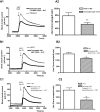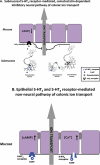Activation of submucosal 5-HT(3) receptors elicits a somatostatin-dependent inhibition of ion secretion in rat colon
- PMID: 20233224
- PMCID: PMC2925486
- DOI: 10.1111/j.1476-5381.2010.00653.x
Activation of submucosal 5-HT(3) receptors elicits a somatostatin-dependent inhibition of ion secretion in rat colon
Abstract
Background and purpose: 5-Hydroxytryptamine (5-HT) is a key regulator of the gastrointestinal system and we have shown that submucosal neuronal 5-HT(3) receptors exerted a novel inhibitory effect on colonic ion transport. The aim of the present study was to investigate the precise mechanism(s) underlying this inhibitory effect.
Experimental approach: Mucosa/submucosa or mucosa-only preparations from rat distal colon were mounted in Ussing chambers for measurement of short-circuit current (I(sc)) as an indicator of ion secretion. Somatostatin release was determined with radioimmunoassay. Intracellular cAMP content was measured with enzyme-linked immunoadsorbent assay (elisa). Immunohistochemical techniques were used to study the expression of 5-HT(3) receptors, somatostatin and somatostatin receptors in colonic tissue.
Key results: In rat distal colonic mucosa/submucosa preparations, pretreatment with 5-HT(3) receptor antagonists enhanced 5-HT-induced increases in I(sc). However, in mucosa-only preparations without retained neural elements, pretreatment with 5-HT(3) receptor antagonists inhibited 5-HT-induced DeltaI(sc). Pretreatment with a somatostatin-2 (sst(2)) receptor antagonist in mucosa/submucosa preparations augmented 5-HT-induced DeltaI(sc). Combination of sst(2) and 5-HT(3) receptor antagonists did not cause further enhancement of 5-HT-induced DeltaI(sc). Moreover, both sst(2) and 5-HT(3) receptor antagonists enhanced 5-HT-induced increase in intracellular cAMP concentration in the mucosa/submucosa preparations. 5-HT released somatostatin from rat colonic mucosa/submucosa preparations, an effect prevented by pretreatment with 5-HT(3) receptor antagonists. Immunohistochemical staining demonstrated the presence of 5-HT(3) receptors on submucosal somatostatin neurons and of sst(2) receptors on colonic mucosa.
Conclusion and implications: Activation of neuronal 5-HT(3) receptors in the submucosal plexus of rat colon suppressed 5-HT-induced ion secretion by releasing somatostatin from submucosal neurons.
Figures








References
-
- Bell D, Zhao Y, McMaster B, McHenry EM, Wang X, Kelso EJ, et al. SRIF receptor subtype expression and involvement in positive and negative contractile effects of somatostatin-14 (SRIF-14) in ventricular cardiomyocytes. Cell Physiol Biochem. 2008;22:653–664. - PubMed
-
- Booth CE, Kirkup AJ, Hicks GA, Humphrey PP, Grundy D. Somatostatin sst(2) receptor-mediated inhibition of mesenteric afferent nerves of the jejunum in the anesthetized rat. Gastroenterology. 2001;121:358–369. - PubMed
-
- Budhoo MR, Kellum JM. Evidence for a 5-HT4 receptor pathway mediating chloride secretion in the rat distal colon. J Surg Res. 1994;57:44–48. - PubMed
-
- Budhoo MR, Harris RP, Kellum JM. 5-Hydroxytryptamine-induced Cl- transport is mediated by 5-HT3 and 5-HT4 receptors in the rat distal colon. Eur J Pharmacol. 1996;298:137–144. - PubMed
Publication types
MeSH terms
Substances
LinkOut - more resources
Full Text Sources

